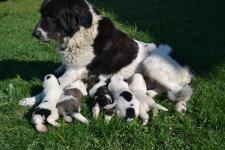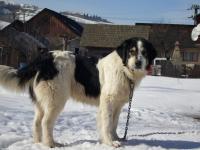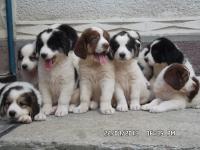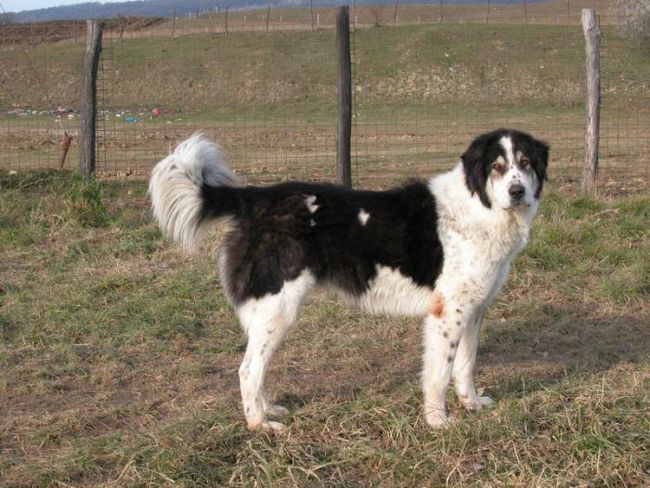| Origin | |
|---|---|
| A place |
Romania Romania |
| Growth | |
| Other | |
| Using |
Flock Protection |
| Classification IFF | |
| Group |
2. Pinscher and schnauzer, molosses, mountain and Swiss cattle dogs |
| Section |
2. Molossi |
| Subsection |
2.2. Mountain Dogs |
| room | |
| Year |
2009 (shareware) |
| % D1% 81% D0% B0% D0% B9% D1% 82% 5B\u003e % D1% 81% D0% B0% D0% B9% D1% 82<=>% 5B\u003e https:% E2% 95% B1% E2% 95% B1commons.wikimedia.org% E2% 95% B1wiki% E2% 95% B1Category: Ciobanesc_Romanesc_de_Bucovina<%5D<)+%7D" class="extiw" title="commons: Category: Ciobanesc Romanesc de Bucovina"> Bukovina Shepherd Dog on Wikimedia Commons | |
Bukovina Shepherd Dog ( room Ciobănesc românesc de Bucovina) - a breed of guard dogs, bred in romanian Carpathians , one of the four breeds of Romanian Shepherds. The dog is strong, large, rough build. Aboriginal work of the Bukovinian sheep-dogs - protection of the herd from predators and intruders. In our time, dogs of this breed are often kept in urban conditions as guards and companions. AT International Cynological Federation the official name of the breed is the Southeast European Shepherd eng. Southeastern European Shepherd.
History of the breed
Bukovina Shepherds come from the region Bukovina in the north-east of Romania. In the Carpathian Mountains, representatives of this breed have been used successfully for centuries to protect flocks and dwellings. Other local names are dulau ( room Dulau, a shepherd's dog) and kapau ( room Kapau). The first breed standard was approved by the Cynological Association of Romania in 1982, updated in 2001. The breed was recognized by the ICF on a provisional basis, the current breed standard No. 357 was approved on May 19, 2009
Appearance
The massive head of the Bukovina sheep dog rises slightly above the back line. Moderately wide skull, the transition from the forehead to the muzzle is slightly indicated. The nose of the nose is black, large, broad. The length of the muzzle is equal to the length of the skull. Muzzle well developed, in the form of a truncated cone, to the nose narrows, but should not be pointed. Lips thick, close to the teeth, with good pigmentation. The dog must have strong jaws with healthy white teeth and a scissor bite, a straight bite is allowed. Cheekbones are not pronounced. Eyes relatively small, almond-shaped, slightly oblique, may be nutty or slightly lighter, but never yellow. Eyelids are well pigmented. Hanging triangular ears with rounded tips are planted high and close to the cheeks. Neck of medium length, thick and strong, without suspension. The body is muscular, the top line gradually decreases from the withers to the rump, the back is sturdy. The chest is wide, with well curved ribs, reaching the level of the elbows. The tail reaches the hock joint or is longer, in a relaxed state lowered, in a stressed state and in motion raised above the level of the back, sickle-shaped. The skin is thick, dark gray. Wool on the head and forelegs short, the body wool thick, straight, thick, hair length 6-9 cm. Undercoat shorter, very dense, light. A long coat on the neck forms a mane. On the back side of the legs are feathers of moderate length. The tail is fluffy, covered with long and thick hair. Color white with clearly defined spots of sand, black or brindle color. On the legs you can black or color. Allowed, but not desirable, color pure white or black.
Temperament
The Bukovina Shepherd was bred to protect herds of sheep and cattle on mountain pasture. These are excellent guard dogs, courageous, militant against wild animals. To outsiders are incredulous. During the night, dogs patrol the territory around the herd or dwelling, when approaching animals or strangers to the protected area signal loud, really powerful barking. They are devoted to the owner, love children, are calm and balanced. Adult Bukovina sheep dogs need to move, they need a sufficient place for walking.
Today 35 years 8 months
A photo



International name:Ciobanesc Romanesc de Bucovina
A country: Rumunia
Year: 1982
Growth: 64.00 cm. - 78.00 cm.
The weight: 68.00 kg. - 80.00 kg.
Life expectancy (in years):11.00 - 13.00
Short descriptions
Bukovina Shepherd Dog - a very large size, a strong and brave guard dog. Appeared in the north-eastern part of Romania in the Carpathians. A fairly rare breed, outside its homeland, is practically unknown. Now these dogs are used as protection of private possessions. These dogs are bold, self-assured, balanced. Betrayed to their master. However, not everyone can raise a dog of this breed. It requires a strong physically and spirit master. Well suited for living in a family. The children are patient, but still they should not be allowed to behave with her untied. These dogs should be treated with respect. And then you will receive a wonderful caretaker and protector for the whole family.
History of the breed
It is believed that these dogs from ancient times guarded pastures in the Carpathians. The exact history of the origin of this breed is unknown, but there are several versions of the appearance of these remarkable dogs. Some believe that the ancestors of the Bukovina sheep dogs were Dasian dogs - hunting and guard dogs of the Thracian tribe, inhabiting the territory of Romania before the arrival of the Romans. Others believe that these dogs appeared in this locality with nomadic tribes. There is also a suggestion that these are Roman military and shepherd dogs that appeared here with their arrival. It is assumed that in the veins of the Bukovina sheep dogs the blood of many dogs flows: the Komondor, the Anatolian and the Hungarian Shepherds, and the Turkish Akbash. This breed was first described by Austro-Hungarians in the middle of the 18th century. The Bukovina Shepherd was recognized by the Romanian Kennel Club. In 2009, the breed received preliminary recognition from the International Federation of Cynologists.
Appearance
Bukovina sheep dogs have a large, massive physique. They have a heavy head with a wide skull. The length of the muzzle is equal to the length of the skull. The muzzle narrows to the nose. Lips thick, close to the teeth. Eyes are medium in size, slightly slanting amber in color. The ears are highly planted, triangular in shape, hanging, adjacent to the cheeks. The neck is powerful and strong, the suspension is absent. Chest broad with convex ribs. The tail is long, fluffy, down; in an excited state takes the form of a sickle. The skin is thick. The woolen cover is thick, straight, long; in the region of the head and forelimbs - short. There is a thick undercoat. There is a mane. Color white or light beige with spots of gray or black, there may be red-pale blotches.
Health, diseases
The most common disease of this breed is dysplasia of the hip and elbow joints. Unfortunately, this disease does not bypass almost none of the breeds of such large sizes. Often there are problems with the eyes, so you need to regularly monitor their cleanliness. You also need to monitor the purity of the ears, there is a risk of infection.
Such a dog will feel better in a large country house with a large backyard. Although now many of these dogs are kept in apartment conditions. These dogs require careful care of the coat. It must be combed every day. Consider that during the moulting period the dog discards a huge amount of wool. Bukovina sheep-dogs are very active and energetic, they need at least daily walks for an hour. They are prone, especially in puppyhood to property damage, so they should have enough of their toys. These dogs are very hyperactive.
Character and temperament
Serious, calm and balanced dog. Courageous and brave, very strong, is capable of fighting with a bear, a wolf and a trot. It can show aggression towards strangers, has a pronounced protective instinct. Faithful and loyal to her master. Majestic and awesome. One of its appearance is enough to prevent outsiders from entering your territory. In the event of a threat of danger or attempt on private property, it immediately attacks. Prone to domination. Is able to get along with other pets, only if she spent with them childhood. Otherwise, it can be dangerous. Has a strong hunting instinct.
Food
Feed adult Bukovina sheepdog enough once a day, despite its large size. In addition, the food should be mainly of animal origin, containing protein. The main food product should be meat and offal. Bukovina sheepdog can eat monotonous food. These dogs can spend some time without food at all, probably due to the harsh mountain conditions in which this breed was formed.Training, training
Bukovina Shepherds are powerful, prone to dog domination. They are very difficult to subdue. Although they are extremely clever, but due to the complexity of the character they can hardly be trained. They need the same authoritative and confident master who will not show caress to the puppy, he must be very reserved with the dog. If you can prove yourself as a leader of a pack, this does not mean that the dog will not try to displace you from this post. Therefore, he always needs proof of your authority.
History of the breed
Bukovina sheep dogs come from the Bukovina region in the north-east of Romania. In the Carpathian Mountains, representatives of this breed have been used successfully for centuries to protect flocks and dwellings. Other local names are dulau (Dulau rum, shepherd dog) and kapau (Kapau rum). The first breed standard was approved by the Cynological Association of Romania in 1982, updated in 2001. The breed was recognized by the ICF on a provisional basis, the current breed standard No. 357 was approved on May 19, 2009
Appearance
The massive head of the Bukovina sheep dog rises slightly above the back line. Moderately wide skull, the transition from the forehead to the muzzle is slightly indicated. The nose of the nose is black, large, broad. The length of the muzzle is equal to the length of the skull. Muzzle well developed, in the form of a truncated cone, to the nose narrows, but should not be pointed. Lips thick, close to the teeth, with good pigmentation. The dog must have strong jaws with healthy white teeth and a scissor bite, a straight bite is allowed. Cheekbones are not pronounced. The eyes are relatively small, almond-shaped, slightly oblique, may be walnut-colored or slightly lighter, but never yellow. Eyelids are well pigmented. Hanging triangular ears with rounded tips are planted high and close to the cheeks. Neck of medium length, thick and strong, without suspension. The body is muscular, the top line gradually decreases from the withers to the rump, the back is sturdy. The chest is wide, with well curved ribs, reaching the level of the elbows. The tail reaches the hock joint or is longer, in a relaxed state lowered, in a stressed state and in motion raised above the level of the back, sickle-shaped. The skin is thick, dark gray. The wool on the head and forelegs is short, the coat is thick, straight, thick, the hair length is 6-9 cm. The undercoat is shorter, very dense, light. A long coat on the neck forms a mane. On the back side of the legs are feathers of moderate length. The tail is fluffy, covered with long and thick hair. Color white with clearly defined spots of sand, black or brindle color. On the legs you can black or color. Allowed, but not desirable, color pure white or black.
Temperament
The Bukovina Shepherd was bred to protect herds of sheep and cattle on mountain pasture. These are excellent guard dogs, courageous, militant against wild animals. To outsiders are incredulous. During the night, dogs patrol the territory around the herd or dwelling, when approaching animals or strangers to the protected area signal loud, really powerful barking. They are devoted to the owner, love children, are calm and balanced. Adult Bukovina sheep dogs need to move, they need a sufficient place for walking.
Origin
| A country | |
|---|---|
FCI Standard No. 357
From the history of the breed:the exact history of the origin of this breed is unknown, but there are several versions of the appearance of these dogs. Some believe that the ancestors of the Bukovina sheep dogs were Dasian dogs - hunting and guard dogs of the Thracian tribe, inhabiting the territory of Romania before the arrival of the Romans. Others believe that these dogs appeared in this locality with nomadic tribes. There is also a suggestion that these are Roman military and shepherd dogs that appeared here with their arrival. It is assumed that in the veins of the Bukovina sheep dogs the blood of many dogs flows: the Komondor, the Anatolian and the Hungarian Shepherds, and the Turkish Akbash. It is believed that these dogs from ancient times guarded pastures in the Carpathians. This breed was first described by Austro-Hungarians in the middle of the 18th century. The Bukovina Shepherd was recognized by the Romanian Kennel Club. In 2009, the breed received preliminary recognition from the International Federation of Cynologists.
Country of origin: Romania and Serbia.
General form:this is a large and strong dog with a slightly rough physique with obvious sexual dimorphism.
Height and weight:height at the withers: males 68-78 cm, females 64-72 cm. Weight: 68-80 kg.
Coat:short hair on the head and chest, long from 6 to 9 cm, straight, thick and coarse on the body, very long coat on the neck forms a mane, fluffy on the tail, on the back side of the hind legs forms a skirt-pants shape. Undercoat is dense, short, elastic, light in color.
Color:white or white-beige with clear spots of gray, black or black with red-pale yellow. On the legs black or gray spots are allowed.
Head: massive, but not heavy, is located slightly above the top line. The nose is big, black. The muzzle gradually narrows to the nose. Skull slightly convex at front view and flat at side view, moderately wide. The upper profile of the muzzle and skull slightly diverge. The occipital protuberance is slightly noticeable.
Ears: placed relatively high and closely adjacent to cheeks, triangular with a slightly rounded tip, not cropped.
Eyes:small, oblique, almond-shaped, brown or slightly lighter (not yellow). Eyelids are well pigmented.
Teeth: scissor bite, strong jaws.
Neck:large, strong, medium length, without suspension.
Housing: The length of the body is slightly larger than the height at the withers. The chest is deep and wide, reaching to the level of the elbows. The bottom line is slightly elevated. The back is muscular, strong. The top line is horizontal. The loins are muscular, strong. The croup is moderately inclined to the base of the tail, muscular.
Tail:thick, saber-shaped. In a calm state, the dog keeps it high, while lowering slightly.
Limbs (front and back):the forelimbs are arranged vertically. Shoulders closely fitting to the body, long, oblique, very muscular. Elbows are pressed to the body. The forearms are not very long, strong. Wrists strong. Pasterns slightly inclined, short. The hind legs are strong and muscular. Hips of medium length, broad, muscular.
Feet:oval, massive and compact. Fingers dense. Nails of ash or black color.
Attractive features:dogs of the Bukovyna Shepherd breed are calm, very loving children, incredulous to outsiders. These are excellent guard dogs, courageous, militant against wild animals. When approaching animals or strangers to the protected area signal loud, powerful barking. During the night, patrol the territory around the herd or dwelling.
Bukovina Shepherd has a strong, dense, large physique. For many centuries this dog was the only assistant of the shepherds holding their flocks in the Carpathian mountains. The main task of such a sheep-dog is to protect flocks and herds from predators or kidnappers. The Bukovina shepherd is valued for his extremely balanced character, calm and friendly attitude to children. These qualities of dogs make it possible to keep them not only as guardians of the herds, but also in the conditions of the city for protection and as companions. This breed is one of the varieties of the Romanian shepherd dog.
Body type
The large, massive head of the dog is raised slightly above the back line. The skull is moderately wide, with a smooth transition from the forehead to the muzzle. The nose is wide, the lobe black and large. The skull is equal in length to the muzzle. The muzzle has the shape of a truncated cone, while it is well developed, tapering to the nose, not sharp. Lips of the dog fit tightly to the teeth, thick, brightly colored. Scissor bite, powerful jaw. Sometimes there are dogs with a direct bite - this is not a disadvantage of the breed. Bukovina sheep dog has weakly expressed cheekbones. Eyes small, almond shaped, slightly obliquely situated. can be nutty or lighter. for this breed are impossible. Eyelids have good pigmentation. The ears are hanging, in the form of a triangle, the tips are rounded, the landing is high, the snug fit to the cheeks. Neck thick, short, strong. Body muscular, strong croup. From withers to groats decrease smooth. A broad chest with pronounced ribs reaches the elbows of the front paws. The tail reaches the hock joint, sometimes longer. At rest, the tail is lowered, with tension or movement rising above the line of the back. The skin of the dog is thick, has wool on the legs and head short, dense, straight. On the body, the wool is longer, up to 9 cm. The undercoat is characterized by a high density, short, light. On the neck, the coat is positioned in such a way that it forms a mane. The back of the legs has a medium-length bump. The tail is fluffy, with a long and thick coat.
Color

Bukovina Shepherd (photo in the article) most often has a white color with spots, which clearly delineate the border. The spots can be black, sandy or tiger. Legs can have a color or black mark. Sometimes it is possible (but undesirable) black or white coat color.
Temperament
The Bukovina Shepherd was taken out specially for the protection of herds, so its character is typical for shepherds / guard breeds. Dogs are calm, very fond of children. They are incredulous to outsiders. Wild animals are not afraid, they enter the fight without hesitation. Lai loud, very powerful. At night, dogs patrol the entrusted territory. Adult dogs require a lot of space for walking.
Attention, only TODAY!
Everything interesting
Dogs of the Chihuahua breed are recognized as the smallest in the world. The most ancient ancestors of the representatives of the breed came from Mexico. Today there is an increased interest in small friendly dogs. Head, neck and muzzle of a Chihuahua
Head shape ...
The Royal Poodle is a very elegant dog from France. This is the largest representative of the poodle breed. Like all poodles, the royal poodle has a superbly developed intelligence, curiosity and mobility. Royal poodles in ...
Rottweiler is an ancient breed of dogs, its ancestors were from ancient Rome. Representatives of the breed are distinguished by their strong character and devotion to their master. Rottweilers need special training. Features of Rottweiler Body Physiology
The Moscow watchdog is a national pride of Russia. Thanks to her spectacular appearance, balanced character, good protective qualities, she becomes an excellent friend and watchman. The Moscow watchdog-the breed of dogs that appeared ...
German Shepherds are considered to be one of the most intelligent dogs. The universality of the breed is that the shepherd is able to perform almost any task. If you decide to get yourself a dog of this breed, then you need to know the basic rules of choice ...

